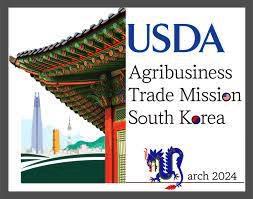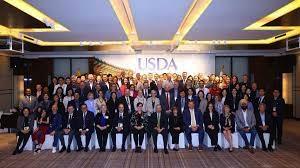 The U.S. and South Korea celebrated the 10th anniversary of a free trade agreement in 2022. In 2023, U.S. agricultural exports to South Korea attained $8 billion.
The U.S. and South Korea celebrated the 10th anniversary of a free trade agreement in 2022. In 2023, U.S. agricultural exports to South Korea attained $8 billion.
The volume of trade between our nations should be increased by the mission comprising 48 agribusiness and farm organizations and five state Departments of Agriculture that took place from March 25th through 28th. The mission reinforced existing arrangements and established new contacts for a wider range of U.S. products.

The American Egg Board was represented by president and CEO Emily Metz and by Greg Hinton, VP of Sales at Rose Acre Farms.
In calendar 2021, South Korea was the third largest importer of U.S. table eggs with 37.8 million dozen valued at $46.7 million. The high volume was attributed to outbreaks of HPAI in South Korea reducing domestic supply. Concurrently, South Korea imported 5,140 metric tons of egg products from the U.S. valued at $13.3million, up 203 percent in volume and 131 percent in value from the previous year during which 1,701 metric tons were imported from the U.S. During calendar 2022, South Korea imported 2,171 metric tons of egg products, down 58 percent in volume and 44 percent in value as domestic production responded to restoration of flocks. In calendar 2023, South Korea was not among the top seven importers of shell eggs but imported 1,141 metric tons of egg products valued at $5.3 million, 45 percent lower in volume and 25 percent in value compared to 2022.
Experience and data confirm that South Korea, among other nations, import eggs and egg products only as required. Landed price and availability are the major determinants of the purchase decision. Shell eggs and egg products are essentially commodities with negligible product differentiation.
The statement that “The AEB is working to drive demand for egg products and build the industry’s trade capacity to facilitate the export of egg products” is subject to question given the motivation to purchase by importers.
 While trade missions provide an opportunity to create new markets for existing products, and to establish contacts with the new importers, South Korea is well aware of the availability of table eggs and egg products from the U.S. with price as the major consideration in the purchase decision. There is obvious recognition of the potential for export of egg products but in this market, the U.S. will compete with India, a low-cost supplier with more favorable transport costs to importers in Asia. A potential point of product differentiation could be the reality that U.S. egg products are devoid of antibiotic residues in comparison with imports from India.
While trade missions provide an opportunity to create new markets for existing products, and to establish contacts with the new importers, South Korea is well aware of the availability of table eggs and egg products from the U.S. with price as the major consideration in the purchase decision. There is obvious recognition of the potential for export of egg products but in this market, the U.S. will compete with India, a low-cost supplier with more favorable transport costs to importers in Asia. A potential point of product differentiation could be the reality that U.S. egg products are devoid of antibiotic residues in comparison with imports from India.
The value of the previous American Egg Board trade mission to South Korea and Japan and the recently concluded program will be confirmed by actual export data. Aspiration is commendable but results are definitive.